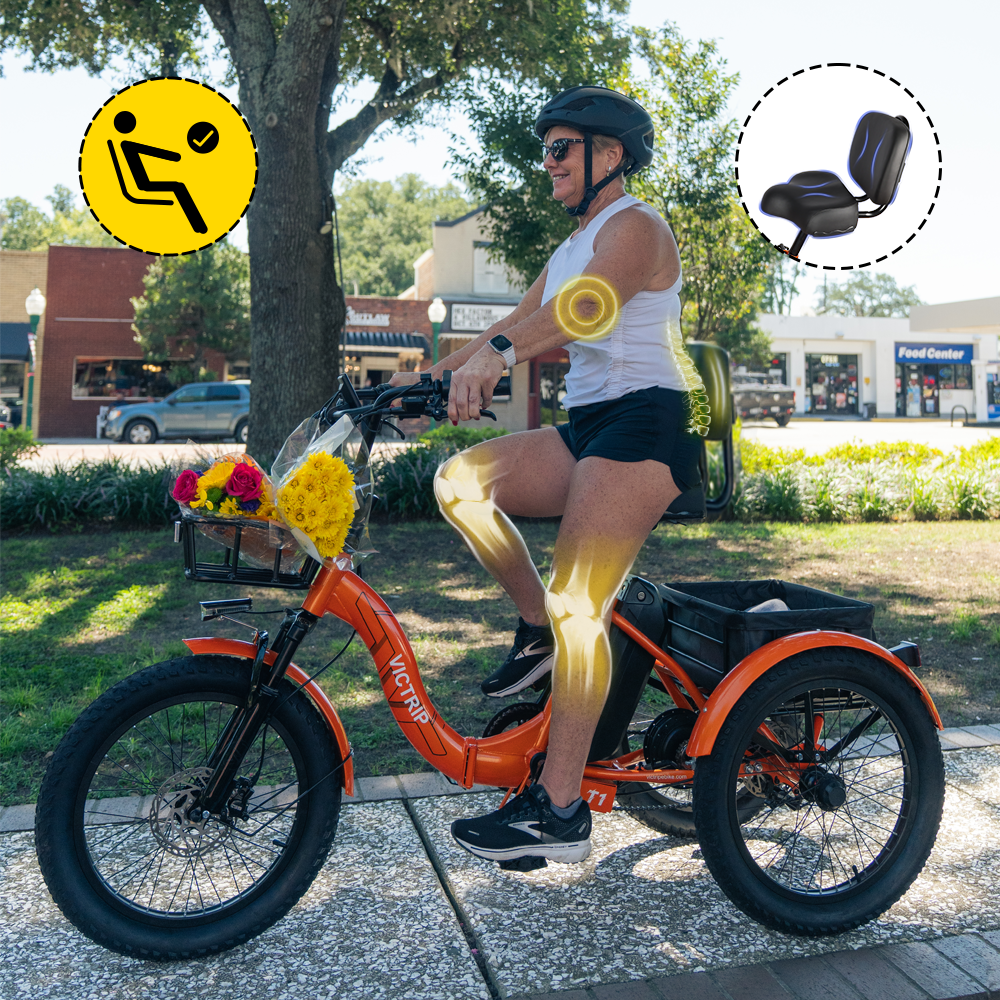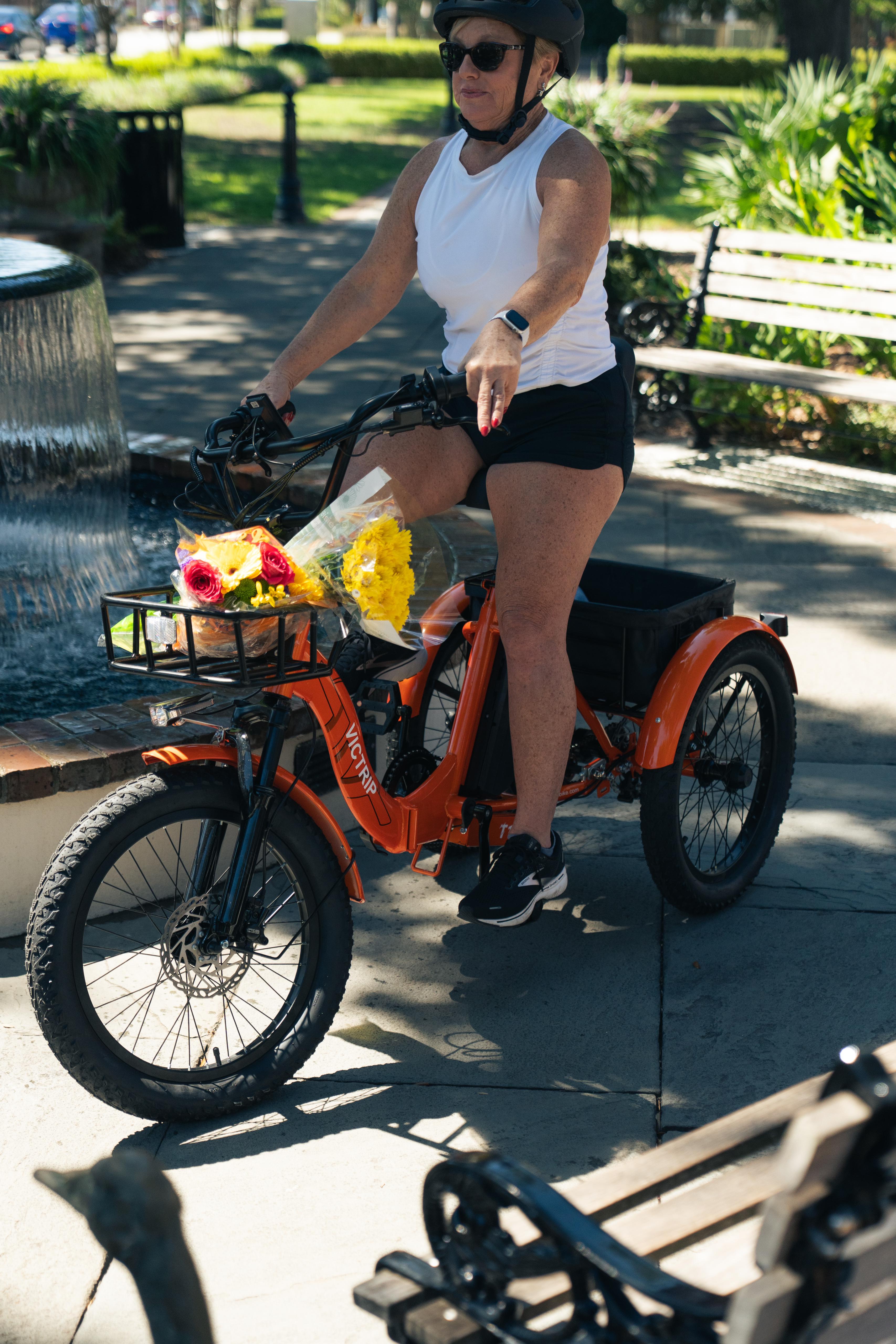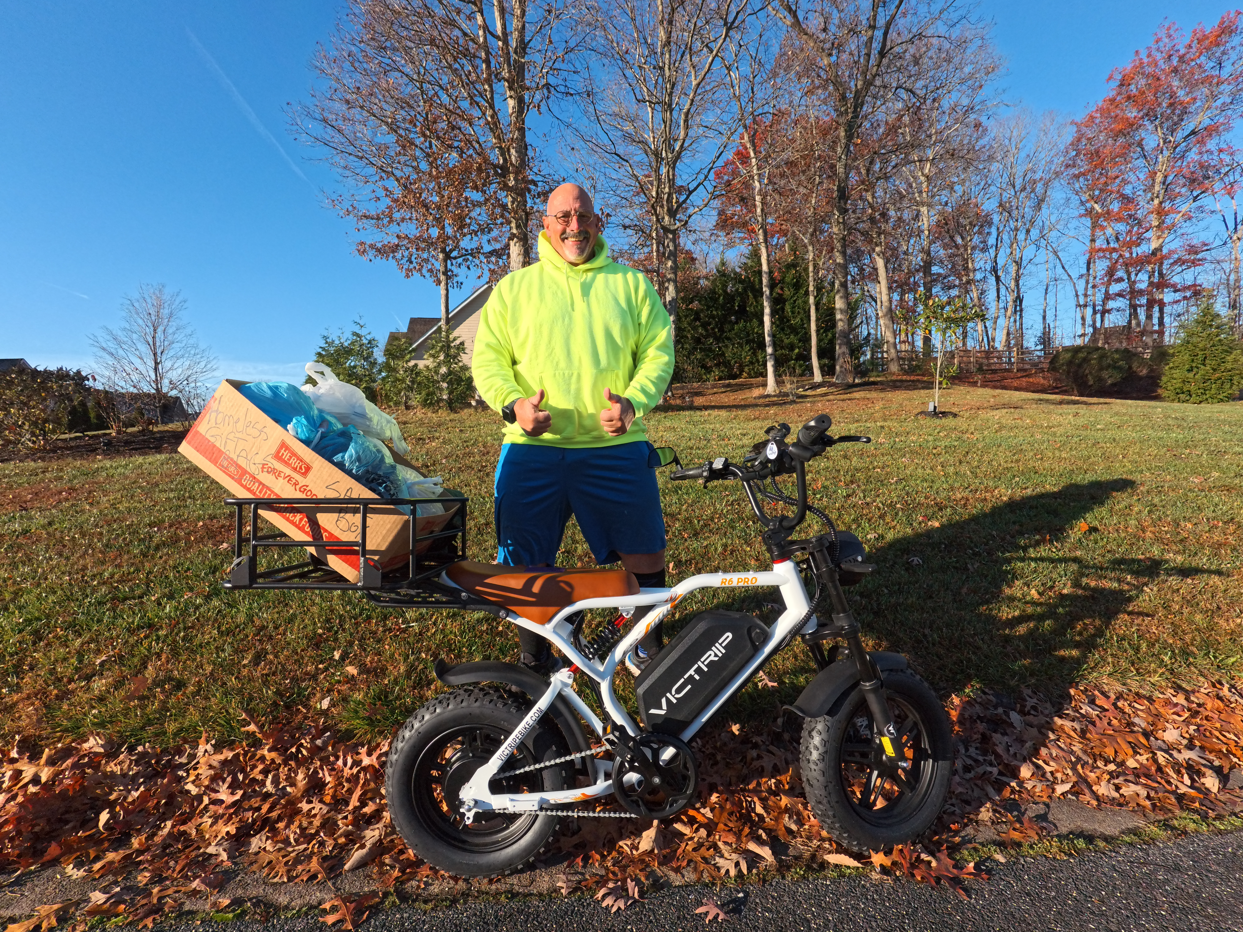
Electric tricycles with rear storage baskets are straightforward, practical machines. They let you carry groceries, pet gear, or work equipment without juggling bags while you ride. Trikes are stable (no tipping like a two-wheeler), often support high payloads, and are friendly for riders with balance or mobility concerns. Studies of cargo-style e-bikes and industry write-ups highlight the cargo and stability advantages of e-trikes, which makes them a go-to for errands and short deliveries.
What to Look For in a Trike with Rear Storage
When shopping for a trike focused on cargo, prioritize these attributes:
Payload capacity (how much it can carry)
If you want to pack a week’s groceries, pickup gear, or a medium pet, look for trikes rated at 300–450 lbs payload or higher. The electric tricycle advertises payloads in the 400–450 lb range — a key selling point for heavy-use buyers.
Battery and range
Battery capacity (e.g., 48V 20Ah) determines practical daily range. For city errands, 30–50 miles per charge is often fine; for longer or hilly routes, aim higher. The electric tricycle advertises up to about 80 miles per single charge in certain listings — note that real-world range varies with load, terrain, and assist level.
Motor power and climbing
A 500–1000W nominal (or 1000W peak) motor gives usable hill performance when you're loaded. If you often face steep streets, favor higher continuous power and torque ratings.
Brakes and safety features
Hydraulic or well-tuned mechanical disc brakes matter because stopping power needs to match the load. Good lighting, reflectors, and a stable seating position make city riding safer.
Basket size, layout, and access
Two types of cargo setups are common: open baskets (easy loading) and covered bins (better security/weather protection). Measure the basket footprint — can it hold a grocery bag, a crate, or a pet carrier?

Essential Specs Explained
Before you buy, understand these terms simply:
-
Range: miles per full charge (practical range will be lower under heavy load).
-
Speed: top assisted speed (often limited by local law; many trikes top at ~20–30 mph).
-
Payload: combined rider + cargo weight.
-
Battery: voltage (V) and capacity (Ah) — higher Ah = more energy.
-
Motor: rated in watts — higher gives more acceleration and hill-climbing ability.
The VICTRIP T1: In-Depth Review
The VICTRIP T1 folding adult trike is marketed as a foldable, heavy-payload electric tricycle with front and rear baskets included. It’s built for errands, short deliveries, or riders who want stability and cargo space without the complexity of a longer cargo bike. On paper, some specs to note:
-
Range: Advertised up to ~80 miles on one charge (real-world varies).
-
Payload capacity: Advertised 400–450 lbs depending on listing — strong for its class.
-
Battery: 48V 20Ah removable pack is commonly listed (good middle-ground for errands).
-
Motor: Motor peaks listed between 1000W and higher in some bundles; take note whether peak or continuous ratings are quoted.
TOP PICK

VICTRIP® T1 Foldable Electric Tricycle
$1,299.00
How those specs translate to daily use
In plain terms: you can expect the T1 to comfortably handle grocery trips, short commutes, and hauling medium cargo. The foldable frame helps in storage, and the included front and rear baskets make short loading/unloading quick. User reviews and seller notes mention that the T1 is beginner-friendly for people moving from an e-bike to a trike.
Pros of the VICTRIP T1
-
High advertised payload — good for heavier users or heavy cargo. Large rear basket + front basket included — immediate cargo utility out of the box.
-
Foldable design aids storage for apartment dwellers.
Cons & caveats
-
Real-world range depends heavily on load and assist; verify expectations.
-
Some buyers report modest shipping/packaging issues (e.g., dented fenders) and recommend inspecting parts on delivery.
-
Local laws vary — check e-trike speed/power regulations before riding on public roads.
Safety, Comfort, and Maintenance
Safety is non-negotiable when you’re carrying a load. Here’s what to check and a simple maintenance rhythm.
Safety checklist
-
Brakes: Test stopping power with weight loaded.
-
Tires: Check inflation; under-inflated tires reduce range and handling.
-
Lights/reflectors: At minimum, front light and rear reflector; better to add strong LED lights.
-
Seat & foot position: Adjust before each ride if several riders share the trike.
Simple maintenance checklist (weekly → monthly)
-
Weekly: Tire pressure, quick visual for spokes and brakes, battery charge level.
-
Monthly: Tighten bolts, lubricate chain (if present), inspect brake pads.
-
Every 6 months: Deep check of wiring, battery health test, professional tune if you ride a lot.
Use Cases: Who Benefits Most
Rear-basket e-trikes like the T1 shine for:
-
Seniors and riders with balance concerns — stable platform and lower fall risk.
-
Errand riders — grocery runs, library trips, light delivery tasks.
-
Small business owners — bakery or local delivery on short routes can be efficient and green.

Comparing Rear Basket E-Trikes
When comparing models, balance these trade-offs:
-
Cargo capacity vs agility: Bigger baskets + payload often mean heavier, slower handling.
-
Range vs weight: Bigger batteries add range but also weight.
-
Price vs features: Some trikes bundle extras (suspension, premium batteries); decide which extras you’ll use.
When to choose a trike vs a cargo e-bike
Pick a trike if stability and easy mounting are priorities; choose a cargo e-bike if you need faster speeds, narrower profiles for bike-lanes, or longer-range commuting.
Accessories & Upgrades
Want to make your trike work harder? Consider:
-
Weatherproof cargo covers or pannier liners.
-
A second battery for extended range (verify compatibility).
-
Better locks (frame-mounted) for street parking.
-
Soft liners for carrying pets safely.
Buying Guide: What to Ask the Seller
Before ordering, ask:
-
Warranty details — battery, motor, and frame coverage.
-
Return policy & shipping insurance — who pays for damage in transit?
-
Assembly support — are tools and instructions comprehensive?
-
Local service options — who can repair or replace parts near you?
Conclusion: Which Rear-Basket Trike Should You Choose?
If your top priorities are stability, cargo capacity, and straightforward utility for errands, a rear-basket e-trike like the VICTRIP T1 is a strong pick. It offers high payload capacity, a sensible battery option, included baskets, and a compact folding form for storage — making it suitable for apartment living, short deliveries, and riders seeking a safe, practical commuting option. Always confirm up-to-date specs, warranty, and local riding laws before you buy. For the latest info and purchasing options, visit the VICTRIP T1 product page.
FAQs
Are electric tricycles with rear baskets street-legal?
Depends on local laws. Many places allow low-speed e-trikes on roads and bike lanes, but restrictions on maximum motor power or speed can apply. Check city and state regulations before riding.
Will the battery last a full day of errands?
That depends on distance, load, and assist level. A 48V 20Ah pack can support many daily chores; heavier loads and hills reduce range.
Can I carry a pet in the rear basket?
Small pets may be fine with proper carriers and safety restraints; larger pets should be carried in purpose-built pet carriers or avoided for safety.
How fast do these trikes go?
Many models top out around 20 mph for assisted speed; some variants advertise higher top speeds but they may be subject to local regulations.
What maintenance affects battery life most?
Avoid full deep discharge routinely, store the battery at moderate state of charge when not in use, and avoid extreme temperatures. Charging habits significantly impact long-term battery health.




Share:
The Ultimate Guide to eBike Brake Pads: Types, Maintenance, and Replacement Tips
Why Electric Tricycles Are Great for Country Living?